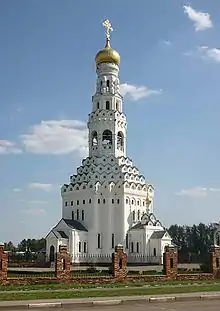51°02′11″N 36°44′11″E / 51.03639°N 36.73639°E


Prokhorovka (Russian: Про́хоровка, IPA: [ˈproxərəfkə]) is an urban locality (a settlement) and the administrative center of Prokhorovsky District of Belgorod Oblast, Russia, along the Psyol River southeast of the city of Kursk. Population: 9,790 (2021 Census);[1] 9,761 (2010 Census);[2] 10,007 (2002 Census);[3] 8,093 (1989 Census).[4]
History
The first mention of the populated area in historical documents dates back to the second half of the 17th century. Polish nobleman Kiril G. Ilyinsky and his son Sava left during the Russian-Polish war of 1654–67 in Poland under the Belgorod, where they founded the suburb Elias. In 1860 Elias Sloboda was renamed in honor of the reigning Emperor Alexander II in the village of Alexandrov. In the 1880s west of the village passed a line of the Kursk-Kharkov-Azov railway. At the same time Prokhorovka station was built, named after the railway engineer V. I. Prokhorov responsible for its construction.[5] In the summer of 1943, Prokhorovka was the site of the Battle of Prokhorovka, a major armored confrontation during the Battle of Kursk of World War II. In July 2013, Vice Prime Minister Dmitry Rogozin offered to establish by 2015 a museum commemorating the battle. The display of armored vehicles will be permanent and the technologies shown there will bring up recollections of the events of World War II.[6]
Transportation
Prokhorovka serves as a railway station on a major railway linking Moscow and the Ukrainian city of Kharkiv.
Gallery
 Orthodox monastery, Prokhorovka
Orthodox monastery, Prokhorovka Black earth, Prokhorovka
Black earth, Prokhorovka Eternal flame war memorial, Prokhorovka
Eternal flame war memorial, Prokhorovka Captured German sword in war museum, Prokhorovka
Captured German sword in war museum, Prokhorovka_-_Russia_(3774259862).jpg.webp) Sparrow in gun barrel of tank, Prokhorovka
Sparrow in gun barrel of tank, Prokhorovka Statue of grieving mother, Hotel Complex Projorovskoe lobby
Statue of grieving mother, Hotel Complex Projorovskoe lobby Victory Memorial, Prokhorovka
Victory Memorial, Prokhorovka Marshal Zhukov depicted on Victory Memorial facade, Prokhorovka
Marshal Zhukov depicted on Victory Memorial facade, Prokhorovka
References
- ↑ Russian Federal State Statistics Service. Всероссийская перепись населения 2020 года. Том 1 [2020 All-Russian Population Census, vol. 1] (XLS) (in Russian). Federal State Statistics Service.
- ↑ Russian Federal State Statistics Service (2011). Всероссийская перепись населения 2010 года. Том 1 [2010 All-Russian Population Census, vol. 1]. Всероссийская перепись населения 2010 года [2010 All-Russia Population Census] (in Russian). Federal State Statistics Service.
- ↑ Russian Federal State Statistics Service (May 21, 2004). Численность населения России, субъектов Российской Федерации в составе федеральных округов, районов, городских поселений, сельских населённых пунктов – районных центров и сельских населённых пунктов с населением 3 тысячи и более человек [Population of Russia, Its Federal Districts, Federal Subjects, Districts, Urban Localities, Rural Localities—Administrative Centers, and Rural Localities with Population of Over 3,000] (XLS). Всероссийская перепись населения 2002 года [All-Russia Population Census of 2002] (in Russian).
- ↑ Всесоюзная перепись населения 1989 г. Численность наличного населения союзных и автономных республик, автономных областей и округов, краёв, областей, районов, городских поселений и сёл-райцентров [All Union Population Census of 1989: Present Population of Union and Autonomous Republics, Autonomous Oblasts and Okrugs, Krais, Oblasts, Districts, Urban Settlements, and Villages Serving as District Administrative Centers]. Всесоюзная перепись населения 1989 года [All-Union Population Census of 1989] (in Russian). Институт демографии Национального исследовательского университета: Высшая школа экономики [Institute of Demography at the National Research University: Higher School of Economics]. 1989 – via Demoscope Weekly.
- ↑ Andrey Mernikov (2021). "Прохоровский район" [Prokhorovsky District]. Геральдика России [Heraldry of Russia] (in Russian). Moscow: LitRes. p. 45. ISBN 9785043185679.
- ↑ "Deputy premier calls for creating Museum of Armor near Belgorod by 2015". Itar Tass. Retrieved July 12, 2013.